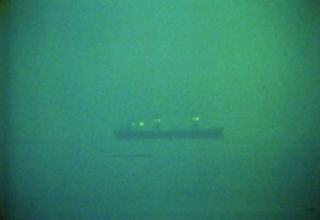Date: 7 November 2007 | Season: Chris Welsby | Tags: Chris Welsby, Systems of Nature
SYSTEMS OF NATURE
Wednesday 7 November 2007, at 8:40pm
London BFI Southbank NFT2
Welsby’s films are dialogues between the filmmaker and the natural elements: the wind controls the movements of the camera in Tree and the film speed in Anemometer. Later films address environmental concerns, such as the threat of radiation as a Geiger counter provides Sky Light’s post-Chernobyl soundtrack. Shifting from environmental structuralism to a more observational mode, the final film Drift has the viewer literally drifting off into a world beyond gravity, into an abstract space between sky and sea.
Chris Welsby, Anemometer, 1974, 10 min
Chris Welsby, Tree, 1974, 5 min
Chris Welsby, Colour Separation, 1975, 3 min
Chris Welsby, Stream Line, 1976, 8 min
Chris Welsby, Sky Light, 1988, 26 min
Chris Welsby, Drift, 1994, 17 min
Chris Welsby will introduce the screening and be available for questions. Curated by Steven Ball, Mark Webber and Maxa Zoller.
PROGRAMME NOTES
SYSTEMS OF NATURE
Wednesday 7 November 2007, at 8:40pm
London BFI Southbank NFT2
ANEMOMETER
Chris Welsby, UK, 1974, 16mm, colour, silent, 10 min
The location for this film is a small London park called Euston Square which is situated close to the busy centre of the city. The camera faces south east across the park, in the foreground there is an expanse of grass surrounded by walkways and luxurious plain trees. In the middle distance is a junction of the busy Euston road, trucks busses and commuter traffic surge past halting only for the traffic lights. The camera angle remained unchanged throughout but the filming speed changed according to the wind speed. The camera motor was driven by an anemometer, a device used to measure wind speed, the harder the wind blew, the faster the camera motor ran, and vice versa. If the wind stopped blowing altogether, no images were recorded, causing a jump cut in the film’s continuity. (Chris Welsby)
TREE
Chris Welsby, UK, 1974, 16mm, colour, silent, 5 min
The camera was placed on the flexible branch of a tree in a strong wind. The composition included both stationary and moving trees (a wooded landscape). The relationship of this landscape to the vertical and horizontal plane was maintained as much as possible. The camera ran continuously until all the film was exposed. The world is seen from the point of view of a tree as its branches sway to the rhythm of the wind. (Chris Welsby)
COLOUR SEPARATION
Chris Welsby, UK, 1975, 16mm, colour, silent, 3 min
This film is based on the colour separation process. High contrast film stock was run three times through a stationary camera; once for each of the light primaries. In the composite image, anything moving is represented in primary or secondary colour whilst anything still, having been filmed through all three filters, is represented in ‘correct’ colour. When projected the film resembles a moving impressionist painting in which time is seen to participate in the construction of the colour image. (Chris Welsby)
STREAM LINE
Chris Welsby, UK, 1976, 16mm, colour, sound, 8 min
This film was made on Mount Kinderscout in Derbyshire, England. It is a continuous, ‘real time’ tracking shot of a stream bed. The length of the track was ten yards. The camera was suspended in a motorized carriage running on steel cables three feet above the water surface. The camera pointed vertically downwards recording the contours of the stream bed and the flow of water along its course. The sound of the water was recorded synchronously from the moving carriage. The ‘drama’ in this film comes from the topography of the stream and not from the camera motion or from the editing. Throughout the unedited length of the film the camera tracks along a straight line at an absolutely regular speed. In contrast the stream runs fast and slow, cascading over boulders and swirling turbulently from left to right. (Chris Welsby)
SKY LIGHT
Chris Welsby, UK, 1988, 16mm, colour, sound, 26 min
An idyllic river flows through a forest, flashes of light and colour threaten to erase the image, bursts of short wave radio and static invade the tranquillity of the natural sound. The camera searches amongst the craggy rocks and ruined buildings of a bleak and windswept snowscape, a Geiger counter chatters ominously in the background. The sky is overcast at first but gradually clears to reveal a sky of unnatural cobalt blue … This film is made in three sections, each leading towards the final abstraction, and each resembling a search for meaning and order amidst a plethora of electronic, chemical and mechanistic information. Space in Sky Light is both highly compressed and volatile; the film challenges the notion of its own form, ending in a beautiful but violent abstraction in which only nature and technology remain. (Chris Welsby)
DRIFT
Chris Welsby, UK-Canada, 1994, 16mm, colour, sound, 17 min
The overall feel of Drift is sombre and mysterious; a study of winter light falling on the surface of water, metal and cloud. The dominant colour is grey; grey infused with a multitude of ocean blues and greens. There is little land in this film and very few landmarks from which to navigate from one space to the next. The picture plane is in continuous motion like the ocean which, on the surface at least, is the subject of Drift. On one level, Drift is a film about the ocean, about winter light and about ships at anchor in a sheltered bay. However, it is also a metaphor, an essentially filmic metaphor about time and space, about being and perception, a metaphor for the act of looking, looking at film and looking at the World. (Chris Welsby)
Back to top
